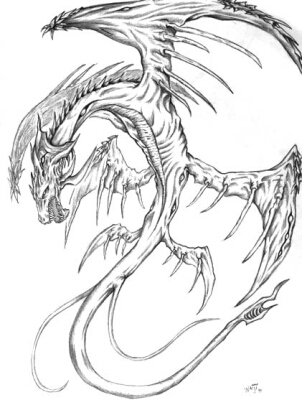
Kahiron Dragons
Description: Large, snake-like dragons with six regressive wings that
had long, curved necks, long skulls, and small bodies. They appear to have
two heads, used as a method for confusing their prey. Other methods of
trickery are the eye-like oval obtrusions located around their bodies. The
posterior portion of each wing is adorned with razor sharp projectiles for
protection. There are no limbs other than their wings protruding from their
bodies. The bodies themselves are covered with grayish scales, giving them a
metallic luster. A powerful tail lies at the base of the body, manipulated
for various tasks.
Species Name: Kahiron.
Familiar Name(s): None.
Average wingspan: 35 ft. from the largest pair of wings.
Average Length: 60 ft.
Average Weight: 1100 lbs.
Texture: Overlapping scales to resemble a somewhat smooth appearance.
Special Abilities: They can create small cyclones by flapping their
wings together in perfect succession from greatest to smallest. Also, they
have the ability to regenerate. This process usually takes two to three
weeks to complete, depending on the severity of the wound.
Natural Habitat: Kahiron dragons usually reside in the high altitudes
of mountains. However, smaller Kahirons may take residence in
the treetops of a dense forest.
Life Span: Kahiron dragons have a life span of one hundred fifty years.
Diet: Kahiron dragons are carnivorous creatures.
Organization: Kahiron dragons are usually found in packs of three.
They are very territorial.
Nature: Kahiron dragons are intimidating at first glance, but are
usually passive creatures. However, they can become highly aggressive when
they feel threatened. It is wise to leave these creatures alone.
Other Qualities: Kahiron dragons have metallic, paramagnetic
silverish lustering bones. Their bones substantiate their snake-like bodies,
being quite resilient and resistant to corrosion. The silvery-white blood of
a Kahiron is considered extremely poisonous, known as Drulnois toxin. If
this chemical comes into contact with an individual by inhalation (it would
have to be mixed profusely with soil) it would cause, in a human: choking, chest
constriction, corrosive to mucous membranes, thus leading to coughing,
painful breathing, bloody sputum, severe headaches, ringing in ears
sensation, dizziness, possible unconsciousness, increased production of
saliva, a running nose, and bloody convulsive vomiting by bleeding of
esophagus. It may have a different effect on nonhuman races, but the Aegishel are the only ones known to have a racial immunity to the poison. It emits an odd faint fragrance that seems like a mix of copper
and kiwi. When in its thick liquid state (state it is originally found in)
it induces a type of erythema (abrupt widening of the small blood vessels
upon the surfaces of the skin, leaving a reddish bruise-like appearance that
will numb the victim and progressively spread along the skin, and
subcutaneous tissues). It is also known to cause sudden fatigue that
gradually drains an individual.
Reactions to other creatures:
Kahiron dragons are territorial, as aforementioned. When another creature
enters a pack's territory, death is usually imminent. They usually eat
lesser animals found wherever they might live. There are stories of Kahiron
dragons feeding on humans, but those are only rumors...
Go back.
Go home.

